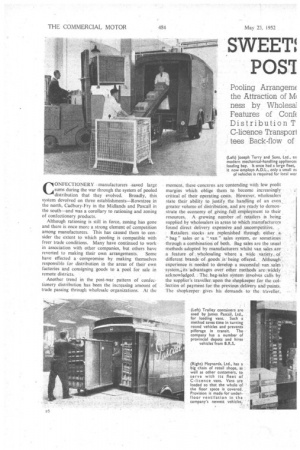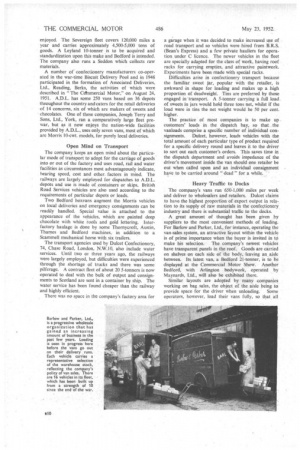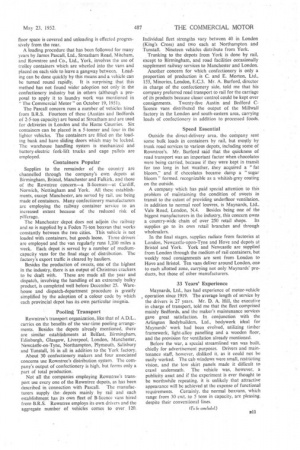Y ROAD: THE VAR TREND
Page 43

Page 42

Page 44

Page 45

If you've noticed an error in this article please click here to report it so we can fix it.
CONFECTIONERY manufacturers „saved large sums during the war through the system of pooled distribution that they evolved. Broadly, this system devolved on three establishments—Rowntree in the north, Cadbury-Fry in the Midlands and Pascal( in the south—and was a corollary to rationing and zoning of confectionery products.
Although rationing is still in force, zoning has gone and there is once more a strong element of competition among manufacturers. This has caused them to consider the extent to which pooling is compatible with freer trade conditions. Many have continued to work in association with other companies, but others have reverted to making their own arrangements. Some have effected a compromise by making themselves responsible for distribution in the areas of their own factories and consigning goods to a pool for sale in remote districts.
Another trend in the post-war pattern of confectionery distribution has been the increasing amount of trade passing through wholesale organizations. At the moment, these concerns are contending with low profit margins which oblige them to become increasingly critical of their operating costs. However, wholesalers state their ability to justify the handling of an even, greater volume of distribution, and are ready to demonstrate the economy of giving full employment to their, resources. A growing number of retailers is being supplied by wholesalers in areas to which manufacturers found direct delivery expensive and uncompetitive. .
Retailers stocks rnare replenished through either a " bag" sales or a "van" sales system, or sometimes through a combination of both. Bag sales are the usual methods adopted by manufacturers whilst van sales are a feature of . wholesaling where a wide variety._ of different b-rands of goods is being offered, Although experience is needed to develop a successful van 1sales 'system,; its' advantages over other methods are widely acknowledged. The bag-sales system involves calls by
• the supplier's traveller, upon the shopkeeper for the collection of paymentfor the previous delivery and points. The shopkeeper gives his demands to the traveller,
within the limitations of rationing-, and orders are made up in the company's dispatch department to be delivered accordingly, the van driver ollecting a signature for them.
Van sales call for no travellers, but driver-salesmen. Suppliers flit their vans with a representative stock and driver-salesmen call on the retailers, who are invited to choose from what is available. A selection is made; the goods are at once supplied and payment is made. This system is obviously more applicable in times of nonrationing, but has found great favour among shopkeepers and those suppliers who operate it to-day.
One wholesale concern working van sales is Barlow and Parker, Ltd., Tamworth Road, West Croydon, and its slogan to retailers is "The Warehouse at your Door." It operates strictly on cash-on-delivery terms and serves retailers in an area roughly semi-circular in shape, extending from Virginia Water to Sidcup And down to
Worthing, Brighton and Eastbourne on the south coast. This area is .di,vided into a number of delivery districts, into which vans run at fortnightly intervals.
The company has built up its immediate post-war fleet from 10 vehicles to 16, consisting of Bedford, Commer, Austin and Morris-Commercial vans ranging in capacity from 15 cwt. to .3 tons. During the day, the dispatch department makes up van loads on the loading bank. The vans are loaded in the morning at 8 a.m. and set off on their rounds by 9 a.m. Each Wednesday the vehicles are kept in for maintenance, so that the -fortnightly delivery cycle is one, of eight " van-running " days. During this period, about 60 tons of goods are dispatched and a total fleet mileage of 3,500 is covered. Mr. D. E Woodcock, general manager of Barlow and Parker, Ltd., told me that transport costs were constantly watched and a sales reorganization was recently effected to reduce them, together with other handling costs. He considered that the van-sales system would be extended when rationing ended. By this method of selling labour costs were reduced, because a driversalesman (more a salesman than a driver, Mr. Woodcock emphasized) combined the functions 4A both a traveller and a van driVer, and warehouse administration was simplified.
Progressive Methods
• His company had secured an increasing volume of business by virtue of its progressive methods, but, like other executives in the confectionery industry with whom I communicated, he was concerned about possible future cuts in the sweet ration. These would be particularly unwelcome, because the concern's methods were designed to be economical in relation to the amount of trade currently handled. A reduction in the ration would cause the overall working cost to be borne by a lower turnover and a further adjustment of methods would be necessary.
A manufacturer distributing entirely through wholesalers is the Sovereign Confectionery Co., Ltd., Loi,vton, near Warrington. This company runs 11 delivery vehicles under C licence, comprising four Leylands, four Bedfords, two Thames and a Morris-Commercial, The fleet dispatches 90 per cent. of factory output, the remainder being consigned by rail.
The special advantage of ancillary operation in this class of work lies in the ability to recover empty containers, but, of course, the other conveniences of Clieence usage common to all such operators arc also enjoyed. The Sovereign fleet covers 120,000 miles a year and carries approximately 4,500-5,000 tons of goods. A Leyland 10-tonner is to be acquired and standardization upon this make and Bedford is intended. The company also runs a Seddon which collects raw materials.
A number of confectionery manufacturers co-operated in the war-time Biscuit Delivery Pool and in 1946 participated in the formation of Associated Deliveries, Ltd., Reading, Berks, the activities of which were described in "The Ofmmercial Motor," on August 24, 1951. A.D.L. has some 250 vans based on 36 depots throughout the country and eaters for the retail deliveries of 14 concerns, six of which are makers of sweets and chocolates. One of these companies, Joseph Terry and Sons, Ltd., York, ran a comparatively large fleet prewar, but as it now enjoys the nation-wide facilities provided by A.D.L., uses only seven vans, most of which are Morris 10-cwt. models, for purely local deliveries.
Open Mind on Transport The company keeps an open mind about the particular mode of transport to adopt for the carriage of goods into or out of the factory and uses road, rail and water facilities as circumstances most advantageously indicate, bearing speed, cost and other_ factors in mind. The railways are largely employed for dispatches to A.D.L. depots and use is made of .containers or skips. British Road Services vehicles are also used according to the requirements of particular depots or loads.
Two Bedford boxvans augment the Morris vehicles on local deliveries and emergency consignments can be readily handled. Special value is attached to the appearance of the vehicles, which are painted deep chocolate with white roofs and gold lettering. Interfactory haulage is done by some Thornycroft, Austin, Thames and Bedford machines, in addition to a Scammell mechanical horse with six trailers.
The transport agencies used by Dulcet Confectionery, 74, Chase Road, London, N.W.10, also include water services. Until two or three years ago, the railways were largely employed, but difficulties were experienced through the shortage of trucks and there was some pilferage. A contract fleet of about 20 5-towers is now operated to deal with the bulk of output and consignments to Scotland are sent in a container by ship. The water service has been found cheaper than the railway and highly efficient.
There was no space in the company's factory area for a garage when it was decided to make increased use of road transport and so vehicles were hired from B.R.S. (Bean's Express) and a few private hauliers for operation under C licence. The newer vehicles in the fleet are specially adapted for the class of work, having roof racks for carrying empties, and attractive paintwork. Experiments have been made with special racks.
Difficulties arise in confectionery transport because the familiar sweet jar, popular with the retailer, is awkward in shape for loading and makes up a high proportion of deadweight. Tins are preferred by those engaged in 'transport. A 5-tonner carrying a full load. of sweets in jars would hold three tons net, whilst if the load were in tins the net weight would be 50 per cent. higher.
The practice of most companies is to make up customers' loads in the dispatch bay, so that the vanloads comprise a specific number of individual consignments. Dulcet, however, loads vehicles with the total amount of each particular type of product required for a specific delivery round and leaves it to the driver to sort out each customer's orders. This saves time in the dispatch department and avoids impedance of the driver's movement inside the van should one retailer be out when called upon and an individual consignment have to be carried around " dead " for a while.
Heavy Traffic to Docks
The company's vans run 650-1,000 miles per week and deliver to wholesalers and retailers. Dulcet claims to have the highest proportion of export output in relation to its supply of raw materials in the confectionery industry and there is substantial traffic to the docks.
A great amount of thought has been given by suppliers to the most convenient methods of loading. For Barlow and Parker, Ltd., for instance, operating the van-sales system, an attractive layout within the vehicle is of prime importance when the buyer is invited in to make his selection. The company's newest vehicles have transparent panels in the roof. Goods are carried on shelves on each side of the body, leaving an aisle between. Its latest van, a Bedford 2I-tonner, is to be displayed at the Commercial Motor Show. Another Bedford, with Arlington bodywork, operated by Maynards, Ltd., will also be exhibited there.
Similar layouts are adopted by many companies working on bag sales, the object of the aisle being to provide space for the driver when unloading. Some operators, however, load their vans fully, so that all floor space is covered and unloading is effected progressively from the rear.
A loading procedure that has been followed for many years by James Pascal!, Ltd., Streatham Road, Mitcham, and Rowntree and Co., Ltd., York, involves the use of trolley containers which are wheeled into the vans and placed on each side to leave a gangway between. Loading can be done quickly by this means and a vehicle can be turned round rapidly. It is surprising that this method has not found wider adoption not only in the confectionery industry but in others (although a proposal to apply it to laundry work was mentioned in "The Commercial Motor" on October 19, 1951).
The Pascal' concern runs a number of vehicles hired from B.R.S. Fourteen of these (Austins and Bedfords of 2-5-top capacity) are based at Streatham and are used for deliveries in London and the Home Counties. Six containers can be placed in a 5-tonner and four in the lighter vehicles. The containers are filled on the loading bank and have sliding doors which may be locked. The warehouse handling system is mechanized and battery-electric fork-lift trucks and cage pallets are employed.
Containers Popular
Supplies to the remainder of the country arc channelled through the company's own depots at Birmingham, Bristol, Manchester and Falkirk, and those of thc Rowntree concern—a B-licensee—at Cardiff, Norwich, Nottingham and York. All these establishments, except Manchester, are served by rail, use being made of containers. Many confectionery manufacturers are employing the railway container service to an increased extent because of the reduced risk of pilferage.
The Manchester ,depot does not adjoin the railway and so is supplied by a Foden 71-ton boxvan that works constantly between the two cities. This vehicle is not loaded with containers, but goods loose. Three drivers are employed and the van regularly runs 1,200 miles a week. Each depot is served by a number of mediumcapacity vans for the final stage of distribution. The factory's export traffic is cleared by hauliers.
Besides the production of sweets, one of the highest in the industry, there is an output of Christmas crackers to he dealt with. These are made all the year and dispatch, involving the handling of an extremely bulky product, is completed well before December 25. Warehouse and dispatch-department procedure is greatly simplified by the adoption of a colour code by which each provincial depot has its own particular insignia.
Pooling Transport
Rowntree's transport organization, like that of A.D.L., carries on the benefits of the war-time pooling arrangements. Besides the depots already mentioned, there are similar establishments at Belfast, Birmingham, Edinburgh, Glasgow, Liverpool, London, Manchester, Newcastle-on-Tyne, Northampton, Plymouth, Salisbury and Tunstall, 16 in all in addition to the York factory.
About '30 confectionery makers and four associated concerns use Rowntree's distribution system. The company's output of confectionery is high, but forms only a part of total production.
Not all the companies employing Rowntree's transport use every one of the Rowntree depots, as has been described in Connection with Pascal'. The manufacturers supply the depots mainly by rail and each establishment has its own fleet of B-licence vans hired from B.R.S. Rowntree employs its own drivers and the aggregate number of vehicles comes to over, 120. Individual fleet strengths vary between 40 in London (King's Cross) and two each at Northampton and TunstaIl. Nineteen vehicles distribute from York.
Trunking to the depots from York is done by rail, except to Birmingham, and road facilities occasionally supplement railway services to Manchester and London.
Another concern for which confectionery is only a proportion of production is C. and E. Morton, Ltd., 155, Minories, London, E.C.3. Mr. A. Burford, director in charge of the confectionery side, told me that his company preferred road transport to rail for the carriage of its products because closer control could be kept over consignments. Twenty-five Austin and Bedford Clicence vans distributed the output of the Millwall factory in the London and south-eastern area, carrying loads of confectionery in addition to processed foods.
Speed Essential
Outside the direct-delivery area, the company sent some bulk loads in containers by rail, but mostly by trunk road services to various depots, including some of Rowntree's. Mr. Burford said that the quickness of road transport was an important factor when chocolates were being carried, because if they were kept in transit for too long in hot weather, They acquired a "fat bloom," and if chocolates became damp a "sugar bloom" formed, recognizable as a whitish-grey coating on the outside.
A company which has paid special attention to this problem of maintaining the condition of sweets in transit to the extent of providing underfloor ventilation, in addition to normal roof louvres, is Maynards, Ltd., Vale Road, London, N.4. Besides being one of the biggest manufacturers in the industry, this concern owns a country-wide chain of over 250 retail shops. Its supplies • go to •its own retail branches and through wholesalers.
In the final stages, supplies radiate from factories at London, Newcastle-upon-Tyne and Hove and depots at Bristol and York. York and Newcastle are supplied from London through the medium of rail containers, but weekly road consignments are sent from London to Hove and Bristol. Ten vans deliver around London, one to each allotted zone, carrying not only Maynards' products, but those of other manufacturers.
33 Years' Experience Maynards, Ltd., has had experience of motor-vehicle , operation since 1919. The average length of service by the drivers is 27 years. Mr. D. A. Hill, the executive in charge of transport, told me that the fleet comprised mainly Bedfords, and the maker's maintenance services gave great satisfaction. In conjunction with the Arlington Bodybuilders, Ltd., bodywork ideal for Maynards' work had been evolved, utilizing timber framework, light-alloy panelling and a wooden floor, and the provision for ventilation already mentioned.
Before the War, a special streamlined van was built, chiefly for advertisement purposes. Drivers and maintenance staff, however, disliked it, as it could not be easily worked. The cab windows were small, restricting vision, and the low skirt panels made it difficult to crawl underneath. The vehicle was, . however, a publicity asset and if the experiment is ever thought to be worthwhile repeating, it is unlikely that attractive appearance will be achieved at the expense of functional requirements. Certainly, the normal boxvans, which range from 30 cwt. to 5 tons in capacity, are pleasing, despite their conventional lines.




















































































